
Assumption parish, new stained glass


From the Archives
By Mary Woodward
JACKSON – In these From the Archives articles I have chronicled a lot about Bishop John Edward Gunn, SM, sixth bishop of our diocese. In this installment I would like to bring to light that Bishop Gunn was a highly sought-after retreat master. Bishops around the country would recruit him to give retreats to the clergy of their diocese.
Therefore, here is a description of his journeys across the country by train in August of 1918. World War I was still raging, and forest fires had been ravaging the western United States. It sounds vaguely familiar in some respects, but also gives a unique view of the development of the Northwest.
“On August 1st I went to Vicksburg where I remained a few hours, taking the night train to Memphis from there. I got the Chicago train at six twenty, reaching the Auditorium on August 2nd. There I heard of the birth of Roy McCanna’s baby – long expected, much prayed for and the most welcome youngster that ever appeared in Wisconsin. I phoned my congratulations from Chicago, and I was requested to stop over on my way to St. Paul to baptize the youngster, which I did on Saturday, August 3rd.
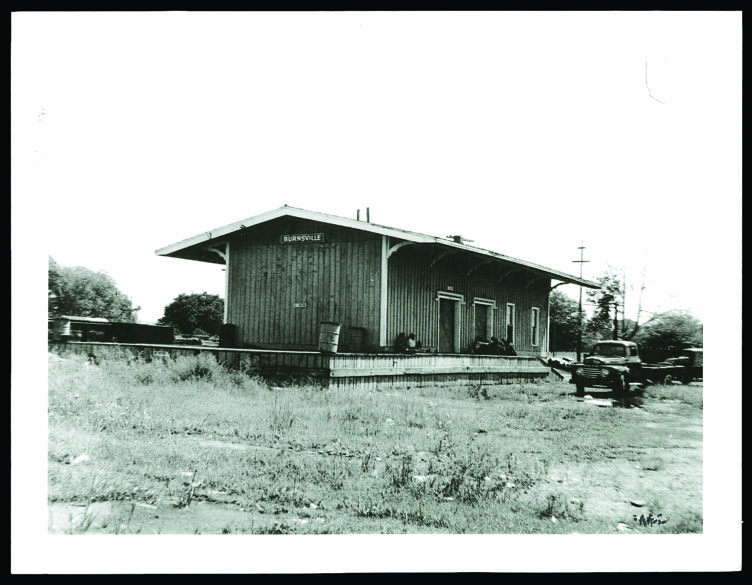
“I left the same night for St. Paul’s and reached the Marists on Sunday, August 4th. I called to see Archbishop Ireland and found him in a dying condition in his new home on Summit Avenue. The Catholics of St. Paul had purchased the finest house in the city and donated it to the Archbishop. He was brought into it, put to bed and he actually never saw the house that was his own.
“I left for St. Cloud on August 5th and went to St. John’s College, the Benedictine Monastery, where I was booked to preach a retreat for the clergy of the Diocese of St. Cloud. I started in on Monday and ended on the following Friday. Bishop Busch of St. Cloud was persuaded by Archbishop Ireland to get me to give the retreat, owing to war conditions which were painfully acute in that section of Minnesota.
“Practically all the Priests and nearly 90% of the Catholics of St. Cloud were pro-German. The Bishop, of German Extraction, was very American and this created a natural state of war or at least of ill-feeling between the Catholics and the Bishop. I was supposed to smooth things out and while the Priests resented a retreat in English, one of the first every given in that language in the diocese, still they treated me very well.
“St. John’s College was a place worth seeing. The community was very large, the Monastery grounds covered 1000 acres, the monks were farmers as well as priests and the place was as near ideal as could possibly be imagined.
“There was a lake in the center of the property which was so thickly stocked with fish that it was almost a crime to throw in a hook and line. It was not fishing – it was slaughter.
“I left St. Cloud satisfied with myself and I think left the Bishop and his priests pretty well satisfied and came to St. Paul where I stopped at the Ryan Hotel. I spent the night of August 10th with the Marists on Cedar Street and helped them out on Sunday and left Sunday night over the Chicago, Milwaukee & St. Paul for Seattle.
“On the train, I met Archbishop Messmer of Milwaukee, and we exchanged a lot of thought between Milwaukee and Spokane. The Archbishop had put his parish church under interdict and excommunicated three or four Polish priests on the day on which we met, so I think he was looking for shelter.
“The trip from St. Paul to Seattle was over some of the wildest parts of America. There was not a town of any importance after leaving Minneapolis. The Rockies were not as wild further South.
“The one thing that was a novelty to me was to go through a country that had been a raging furnace for over two years and a half and defied the power of the United States to put out the forest fires. The country showed the ruins of fire and looked as sad a spectacle as could be imagined.
“On the trip, I saw for the first time a railroad actually controlled and propelled by electricity. The big Mountain engines could not do the work and tremendous electric power houses were installed all along the line and engines equipped to suit. We zig-zagged around the Mountain and took a day to travel a bee line distance of thirty or forty miles. The trip was pleasant as we reached Seattle on August 14th.”
In my opinion, bishops are not always appreciated until years after their tenure. Bishop Gunn certainly had his moments during his time in office that caused consternation among clergy and faithful, but we are very fortunate to have his diary to share his adventures in the early 1900’s from his unique perspective. Now, more than 100 years later time sheds light on the wisdom of his actions.
In our next installment, we will continue this journey with Bishop Gunn as he shares his keen wit and intellect across the country.
(Mary Woodward is Chancellor and Archivist for the Diocese of Jackson.)
By Bishop Paul S. Coakley, Archbishop of Oklahoma City, Chairman of the Committee on Domestic Justice and Human Development
Sept. 5, 2022 – The church often looks at the well-being of society through the lens of the well-being of the family. As Pope Francis said during his visit to the United States in 2015, “We cannot call any society healthy when it does not leave real room for family life. We cannot think that a society has a future when it fails to pass laws capable of protecting families and ensuring their basic needs…”1 This Labor Day, let us reflect on how we can build a more just economy by promoting the welfare of working families through both charitable works and through advocacy for improved policies such as expanding the Child Tax Credit and passing the Pregnant Workers Fairness Act. Advancing these two policies would have a profound impact on family stability, especially for families who are financially vulnerable.
Some recent reports have found the economy is returning to a pre-pandemic norm with regards to unemployment rates.2 However, other reports demonstrate that, while wages are rising, much or all of the increases are lost to inflation, which affects low-income families the most and puts our economy in a precarious position.3 I pray that government leaders who deal with inflation may have prudence in addressing its complexities and challenges.
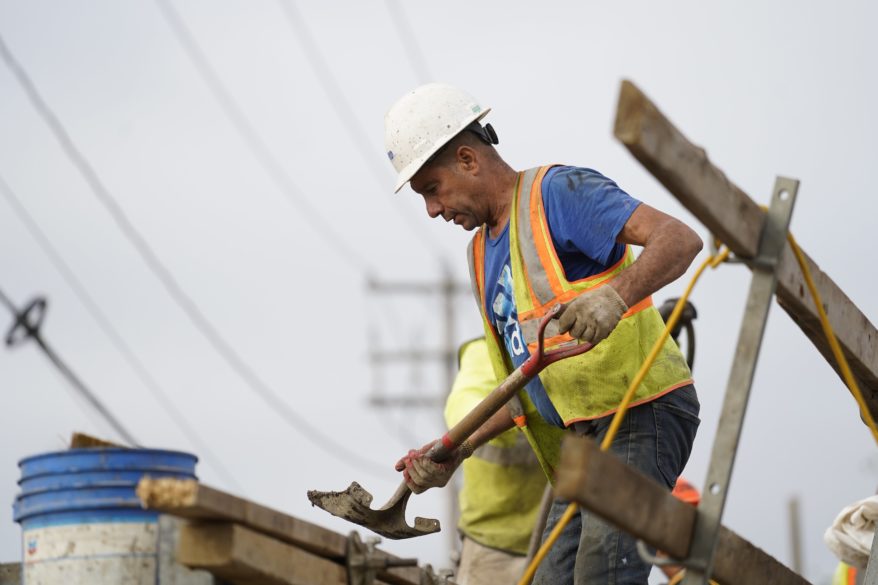
But pre-pandemic norms were far from perfect. Even before current economic uncertainties, women – especially women of African descent and Latina women – earned less than their male counterparts, including when doing the same work with the same qualifications. They filled the majority of direct care jobs, experiencing increased risk of injury, high stress, and exposure to illness while earning low wages.4,5 They were the majority of caretakers for their loved ones, yet many lacked adequate family and medical leave policies. These and other economic challenges continue to affect working families and children.
This is also the first Labor Day since the Supreme Court’s reversal of Roe v. Wade. The ruling is an incredibly significant step towards healing the deep wounds of abortion and protecting all preborn human life. But our aim as Catholics has always been, and remains, to build a society in which abortion is unthinkable. This unique moment necessitates a society and an economy that supports marriages, families, and women; it demands that all of us reach across political aisles and work diligently to reframe social policies in ways that are pro-woman, pro-family, pro-worker and, thus, authentically pro-life.
One of the USCCB’s policy priorities this Congress has been supporting the Pregnant Workers Fairness Act (PWFA). There is currently no federal law requiring employers to provide short-term, reasonable accommodations to pregnant women in the workplace and the PWFA would do so. Common requests include being able to carry a bottle of water, a stool for jobs that involve long periods of standing, or lighter duty for jobs that entail heavy lifting. Women in low-wage and physically demanding jobs, disproportionately held by women of color, are regularly denied these simple accommodations and terminated or forced to take leave without pay.6 A number of states already have laws like this in place; however, pregnant women in every state should be protected by these standards. No woman should be forced to risk her or her child’s health, miscarriage, preterm birth, economic security or losing insurance benefits just because she requests a short-term, reasonable, pregnancy-related accommodation. The U.S. House of Representatives has already passed this bill with strong, bipartisan support. Now, with a short time left in this current legislative session of Congress, we urge immediate Senate passage of this proposal that would make the workplace safer for women and their preborn children. Hundreds of Catholics who participated in this year’s Catholic Social Ministry Gathering advocated for this bill in meetings with their U.S. Senators and we encourage Catholics to continue doing so through the advocacy center on the USCCB website.
The USCCB has also been actively advocating in favor of expanding the Child Tax Credit (CTC). In 2021, the CTC provided financial relief for families who were having difficulty making ends meet. Families largely spent this money on food, energy bills, housing payments and other basic needs. With rising inflation, continuing to expand this tax credit would be critically helpful to families forced to choose between buying food and filling up their gas tanks. Congress should move forward with a CTC proposal that has no minimum income requirement, includes families with mixed immigration status, is available for the year before birth, and is offered to every child – regardless of the size of the family. The CTC was enormously effective at reducing child poverty in 2021 and we should not regress from this progress.
Additionally, the USCCB supports federal paid leave policy, just wages, and the right to organize. We have long called for a system in which the whole of society enjoys fundamental human needs including nutrition, affordable housing, education, and health care. These common goods cannot be achieved through individual efforts alone, but require the collaboration and cooperation of everyone, and the exclusion of no one.
Just as significant as federal policy, there is much work that can be done locally to advance the dignity of work. For example, there are always opportunities to volunteer to help struggling families, such as with Catholic Charities. Additionally, the efforts of labor unions have helped union workers fare better during the pandemic than non-union workers, as they were more likely to maintain their pay and their jobs. To this end, the Catholic Campaign for Human Development supports organizations that work on low-wage workers’ rights and training, in an effort to eliminate labor trafficking and related workplace abuses such as wage theft.
Finally, in writing this Labor Day reflection, I am reminded of Monsignor George Higgins, who passed away 20 years ago this year. He was a fervent advocate of economic justice for all, working closely with unions and union organizers, including Cesar Chavez and the United Farm Workers, and received many awards, including the Presidential Medal of Freedom. He was the director of what was then called the Social Action Department of the bishops’ conference and, in fact, wrote or was consulted on the U.S. Catholic bishops’ Labor Day statements for decades. Inspired by him, let us continue his good work in building a just society for all. May the spirit and example of Monsignor Higgins inspire us, that we might have the wisdom to build up justice and improve the lives of workers and their families as he did throughout his life.
1 Pope Francis, Prayer Vigil for the Festival of Families (Sept. 26, 2015). Apostolic Journey – United States of America: Prayer vigil for the Festival of families at the B. Franklin Parkway (Philadelphia, 26 September 2015) | Francis (vatican.va)
2 U.S. Bureau of Labor Statistics, Employment Situation Summary (Aug. 5, 2022). https://www.bls.gov/news.release/empsit.nr0.htm
3 U.S. Bureau of Labor Statistics, Employment Cost Index Summary (July 29, 2022). https://www.bls.gov/news.release/eci.nr0.htm
4 PHI. Direct Care Worker Disparities: Key Trends and Challenges (Feb. 8, 2022). https://www.phinational.org/resource/direct-care-worker-disparities-key-trends-and-challenges/
5 PHI. Workplace Injuries and the Direct Care Workforce (April 20, 2018). https://www.phinational.org/resource/workplace-injuries-direct-care-workforce/
6 A Better Balance. Long Overdue: It is Time for the Federal Pregnant Workers Fairness Act (May 2019). https://www.abetterbalance.org/wp-content/uploads/2019/05/Long-Overdue.pdf
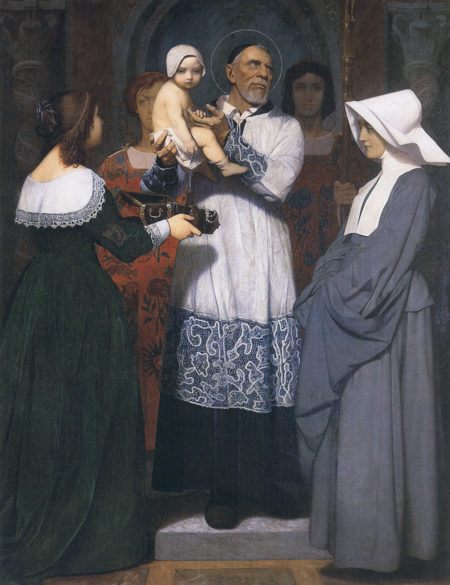
Stewardship Paths
By Julia Williams
JACKSON – St. Vincent de Paul’s holiness had a heart for the poor and was dedicated to the service of those suffering from poverty. He founded the Vincentians and the Daughters of Charity, and over the course of time established many local charitable groups, urging members to see Christ in the poor and attain holiness in their service.
St. Vincent placed service to the poor above nearly every activity in his life. He would maintain: “When you leave your prayer to care for a sick person, you leave God for God. To care for a sick person is to pray.”
His humility and generosity have propelled Christians to greater charity for centuries. Many parishes today have a St. Vincent de Paul Society, or other parish ministries, which carries on the work for the poor.
The feast day of St. Vincent de Paul is Sept. 27, which is the date of his passing in 1660. He is the patron saint of all charitable works.
St. Vincent practiced the seven Corporal Works of Mercy, which are obvious expressions of stewardship.
• Feed the hungry
• Give drink to the thirsty
• Clothe the naked
• Welcome the stranger
• Heal the sick
• Visit the imprisoned
• Bury the dead
A life lived in concern for others is perfect stewardship. Taking care of all God’s creation is the stewardship way of life.
Excerpts: simplycatholic.com
By Berta Mexidor
TUPELO – Certificates of Continuing Education in Theology and Ministry from Loyola University in New Orleans was presented to a group of twelve Hispanic leaders from deanery five, after a four-year period of study and perseverance, at a special Mass on Saturday, Aug. 27 at St. James parish in Tupelo.
Traveling from New Orleans for the special presentation were assistant professor and director, Tracey Lamont, Ph.D. and director of the Loyola Institute Program for the Extension of the Ministry (LIMEX), Thomas Ryan, Ph.D. The Mass in honor of these dedicated Hispanic leaders was celebrated by Father Timothy Murphy, concelebrated with Fathers Henry Shelton and Mario Solorzano, and assisted by Deacon Carlos Solá. Loyola University New Orleans offers master’s and certificate programs to lay ecclesial ministers (LEMs), as well as parish leaders.
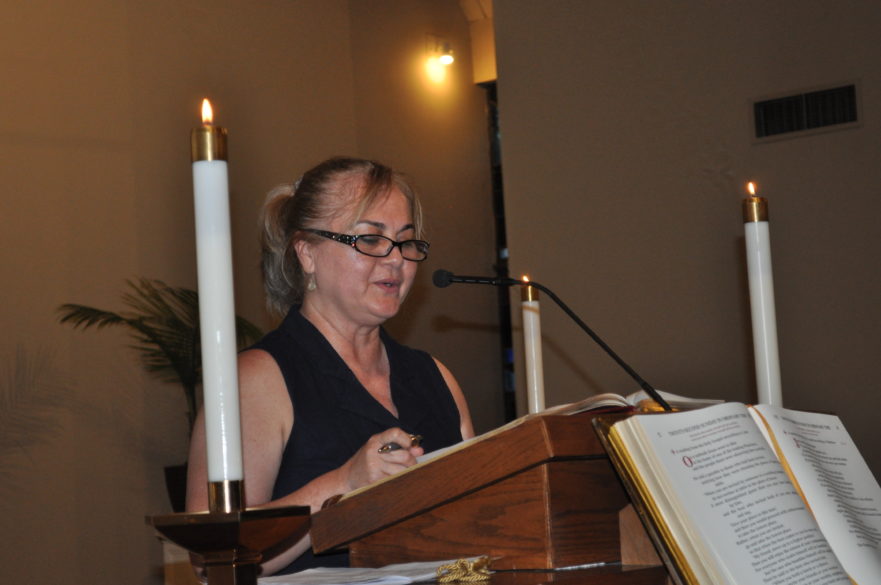
Certificate awardees include Raquel Thompson, Maria de Jesus Hernandez, Alejandro Lopez and Yolanda Chavez of St. James Tupelo; Magaly Heredia, Mariano Hernandez, Luis Rosales, Teresa Perez and Bernardo Sorcia of St. James Corinth; Luis Gordillo of St. Christopher Pontotoc; Eduardo Padilla of St. Matthew Ripley; and Maria Cecilia Leon of St. Helen Amory. Each were sponsored by the office of Diocesan Faith Formation.
The group also received Loyola Institute’s Kairos Award for Ministry last May during the Loyola College of Nursing and Health Honors graduation ceremony. The Greek word kairos means a ‘…full spirit when people and circumstances come together in an extraordinary way to fulfill God’s will in the world.”
Facilitating the group was Danna Johnson, who earned a masters from Loyola in 2019 and is now a LEM at Immaculate Heart of Mary Houston. Sisters Carol Ann Prenger, SSND of Ripley, and Jane Wand, SSND of Booneville were also supportive and motivating the group, accompanying them along the way.
In his homily, Father Mario said that studying theology for four years is a great achievement, but that in the case of lay people, unlike priests, the task is double because in addition to studying it “…you all put it into practice the days in their lives as families, at work, and in their communities. That is why you see faith in a different way,” and he urged them to use the knowledge gained even more.
Father Tim explained that LIMEX has helped groups from Natchez to Tupelo. “A large part of the funding for the translation of the materials into Spanish was provided by the family of Betty Montgomery. She was an early supporter of LIMEX, with a Ph.D. in English, who was tragically killed in an accident in Tupelo about 10 years ago,” said Father Tim.
The LIMEX program came to Tupelo in 2008. Dr. Len Pinkley, a LIMEX pioneer, recalled in his speech the support he received and the enduring friendships created in the group, made up of six members of the Tupelo community, including one non-Catholic. Dr. Pinkley also paid tribute to departed members, including the late Betty Montgomery.
Speaking to the group of twelve leaders, Father Tim says with admiration that after they “…studied together for three years, they are the first to complete the certificate in Spanish.” Father Tim concluded saying that these twelve leaders “…are a great story of overcoming, commitment, evangelization and collaboration.”
Dr. Lamont commended the graduates for their commitment to the program and thanked the parish of St. James and the Diocese of Jackson for the collaboration. “Our educational partnership has been a blessing for Loyola,” she said.
When speaking to those who were her students, she also commended them for having “helped each other on a long and arduous road” where they also learned to overcome the challenge of dialoguing and criticizing with respect.
“You have engaged each other in authentic dialogue, critical reflection challenge, and affirmation. Truly, you have earned the right to call yourselves a learning community,” said Dr. Lamont.

By Catholic Extension
BILOXI – Start with your open right hand, palm face out, shoulder high. Move your right arm to the left, gently, like a mother gathering her children. Crossing your chest, touch the side of your right hand to your left shoulder.
Then raise both hands to the sky, the left hand slightly higher than the right, a silent show of praise. With your closed hands, a horizontal line just above the head, forming an altar, gracefully extend your fingers and pull your hands apart, like birds taking flight.
This is how to sign the words “Our” and “Father” — a hand that crosses the heart, open hands raised to the sky, just above the head, gracefully acknowledging the God space in which we always dwell.
Helen Keller once said, “Blindness separates people from things. Deafness separates people from people.”
The isolation that deafness brings is almost unimaginable for the hearing, who have no idea what the deaf have to go through to participate in a hearing world. Gregory Crapo, director of the de l’Epee Deaf Center in Biloxi, Mississippi, knows this well.
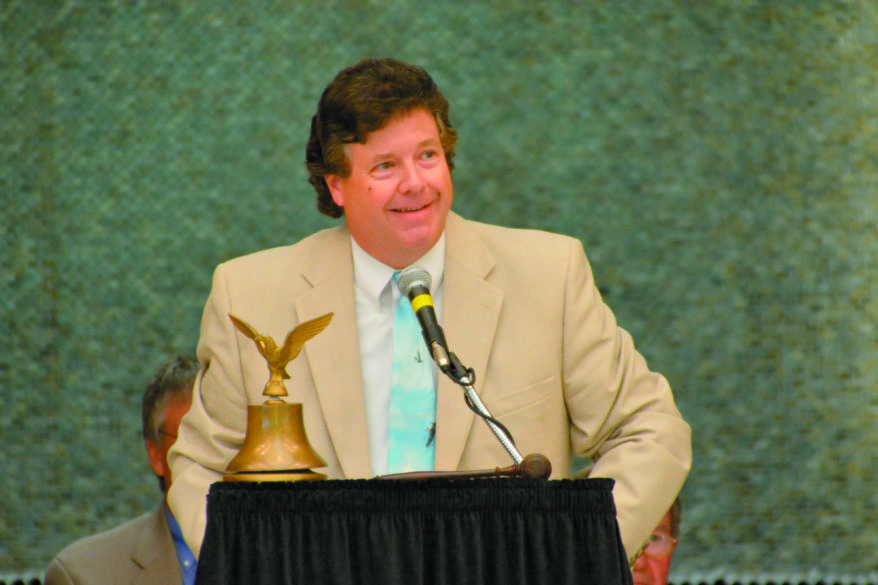
Community is key
The ministry was established in Biloxi in 1977 by Daughter of Charity Sister Dolores Coleman. Since 2003, Crapo has served as the center’s director. Today, Crapo and his staff of three promote independence and inclusion in the community for the deaf, hard of hearing and disabled. Catholic Extension has supported the ministry for more than 30 years.
Community is the key word. Community is the only way to end the isolation that deafness brings.
This ministry is as expansive as it is innovative. Crapo and his staff provide interpreting services for the Diocese of Biloxi and its neighbors. Universities and hospitals utilize these services, as do teachers, police and the court system.
Providing interpreters is just a small part of de l’Epee’s mission. The center creates a community in which the deaf and hard of hearing have all the activities and services a hearing community would have.
Crapo has led the expansion of a wide array of social services including American Sign Language (ASL) classes, a food pantry, transportation and emergency services during extreme weather, such as hurricanes.
Young people go on field trips, participate in dances and attend retreats. They receive educational services from academics to religious instruction. Camp D.E.A.F. (Deaf Enabled to Associate for Fun and Friendship) offers five days of recreational activities for children ages 5 to 14. Older teens and young adults trained in ASL serve as camp counselors and are drawn further into empathy and mission. An outside prayer grotto is being planned to help young people know that the call to pray is always and everywhere.
From debt to expansion
When Crapo first arrived, the center was struggling with debt. His leadership has enabled de l’Epee to become debt free, financially stable and in a position to grow its mission. Its outreach is at an all-time high. More and more deaf and hard-of-hearing people are moving into the area for the center’s services.
The ministry is reaching an expanded population through a new branch called The Tabitha Project, which will serve the blind, deaf-blind and people with special needs. Crapo also helped establish a clinic that provides eye surgeries to people in need.
Bishop Louis Kihneman III of Biloxi said, “Greg has been challenged with expanding our established ministry to people of all disabilities while understanding the differences in each area of need.”
Crapo said that the Catholic faith comes alive in sign language. He believes that the sign for “Jesus Christ” is the most powerful. It is the symbol for “king” with a C hand shape and the third finger of each hand touching the opposite palm representing Jesus’ wounds. Crapo says, “Working with our most vulnerable populations is the best way to walk in Jesus’ footsteps.”
In a thank-you note to our donors, Crapo wrote, “Your commitment to Catholic Extension allows us to make our community a better place and is a great inspiration, helping ensure that the staff and volunteers of de l’Epee can provide critical assistance when needed.”
There are those who take advantage of the deaf. Crapo believes that trust building is the most important part of his ministry because such wounds can only be healed through love and in community. Crapo’s trust in God’s love animates his ministry. De l’Epee is truly God’s space.
So, start with a hand that crosses the heart, open hands raised to the sky, hands just above the head, gracefully praising the God space in which we always dwell.
(Catholic Extension is honored to share the accomplishments of Gregory Crapo, a finalist for the 2022-2023 Lumen Christi Award. Visit this page to read other inspiring stories from this year’s finalists: https://www.catholicextension.org/lumen-christi-award/lumen-christi-award-finalists.)
Kneading Faith
By Fran Lavelle
I have been calling for a lay revolution for years. Before anyone calls the Vatican to have me arrested for inciting an insurrection against the church let me be very clear about what I mean.
I am not asking for a lay revolution against the church; rather one within the church in collaboration with the ordained and consecrated. For generations upon generations religious sisters and brothers catechized our children, Father made sick calls to the hospital and nursing homes. Father gave instructions for those seeking to come into the church. He also prepared couples for marriage. Lay people had roles as cooks, housekeepers and janitors, but the heavy lifting of ministry was undertaken by clergy and religious.
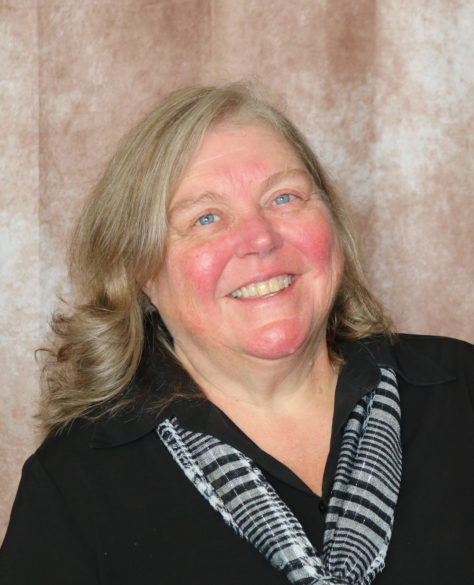
In the past nearly 60 years since Vatican II we have seen a sharp decrease in the number of clergy and religious serving the church. Perhaps the laity has not been empowered or encouraged to do so, but it the Synod made it clear that everyone must take part in undertaking the work of the church. The ordained and religious can no longer shoulder that responsibility alone. The lay revolution I am speaking of is for us, the laity, to step up to the plate and take responsibility for our faith and the ministries of the church in a transformational way. We have looked to the leadership of the church to tell us what to do.
The listening sessions for our Synod demonstrated that we, the laity, know what is needed to move beyond a transactional faith. People around this diocese asked for better faith formation of both youth and adults, you asked for an end to partisan politics, you asked for greater unity, you asked for healing. You asked that we do a better job keeping the young church engaged and active.
All that we heard, all that the faithful are seeking is within our grasp. There are more programs, podcasts, video series, websites and resources than one could ever have imagined. We do not need better resources. We do not need a better textbook for education our children in the faith.
We need to call on the Holy Spirit to fill us with a passion to use the resources and tools that we have been given and become leaders within our parishes and communities. What we are in need of are doers of the Word. We need people to say in earnest, “Here I am Lord, I come to do your will.”
How do you become a transformational leader in the church? If you see a need, talk to others in your community about what they see. Get input from people who do not look like your or think like you. If the need is validated, develop a plan. Take your plan to the parish council or your pastor/LEM.
Often parishioners come to the church office to bring up a need to the pastor but do not have constructive ideas on how to address the issue. I am not advocating that we all act like urban cowboys and bust up the pastor’s office hell bent on doing what we want. I am suggesting that when we see a need, develop solutions, seek input, listen to others and present a well-formed plan for addressing the issue. We have clutched our pearls for far too long. We have looked to the clergy or someone else to address the issues facing the church.
I have a plaque in my office that says. “Teamwork divides the task and multiplies the success.” If we want vibrant, dynamic, communities of faith we have to be dynamic and vibrant people of faith. Multiply the success of your parish community. Be a part of the solution. Step up. Show up. Share the journey.
(Fran Lavelle is the Director of Faith Formation for the Diocese of Jackson.)
By Catholic News Service
WASHINGTON – Evangelizing the whole church, taking personal responsibility for the mission to evangelize, engaging youth and young adults better, accompanying families, asking parishes to become more welcoming, understanding the experience of LGBTQ+ Catholics and allowing more women in church leadership roles.
These are some common themes that surfaced in a sampling of U.S. dioceses’ synthesis reports on listening sessions they held in preparation for the world Synod of Bishops on synodality in October 2023.
Dioceses utilized several different tools and opportunities to gather feedback: in-person and online group listening sessions, one-on-one meetings, targeted outreach efforts, online surveys and other methods.
In the listening phase, members of parishes, dioceses, religious orders and Catholic movements were asked to consider the ways in which they currently experience the church as “synodal,” that is, as a community that walks together, and to suggest ways to strengthen that in practice.
A synthesis of the listening sessions formed a report each diocese had to submit to the U.S. Conference of Catholic Bishops; 16 regional teams were working on drafting regional reports synthesizing diocesan reports.
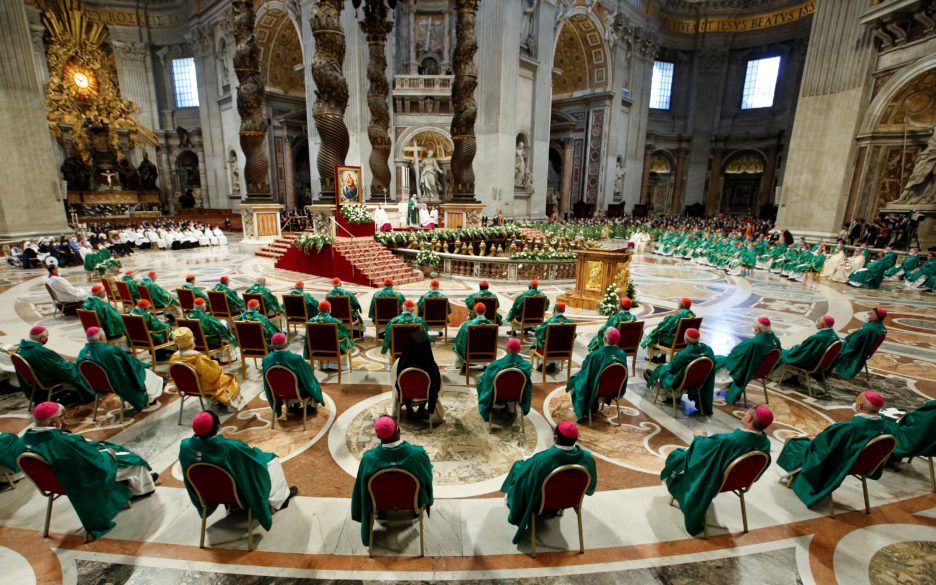
The USCCB will in turn synthesize the summaries from throughout the nation for a report to submit to the Vatican Secretariat of the Synod of Bishops.
The secretariat will use the reports from bishops’ conferences around the world to develop the “instrumentum laboris,” or working document, to guide continental or regional ecclesial assemblies that will take place by March 2023.
“Pope Francis’ vision for the synod called for the largest consultative process both in the history of the Catholic Church and the history of humankind,” said Seattle Archbishop Paul D. Etienne, who attended several local gatherings.
The archdiocese’s report captures feedback from nearly 1,000 online and in-person gatherings since January, involving over 11,000 people across western Washington.
“I’m so proud of the many thousands of people in western Washington who led, participated and invited others to prayerful dialogue. These events were marked by prayer, heartful sharing and attentive listening,” Archbishop Etienne said.
“The purpose was not to determine solutions; rather to practice walking with each other as church, to listen for the Holy Spirit and to begin to discern what God is asking of us in our time,” he added.
Suggested discussion prompts were intentionally broad. One participant described the synod as “an official, church-sanctioned conversation in which there are no taboo subjects, no off-limits subjects, no wrong answers.”
More than 90% of the archdiocese’s parishes are represented in its synod synthesis report. Additionally, listening sessions were held with students, the imprisoned, Catholic Community Services of Western Washington and women religious.
In the Archdiocese of Louisville, Kentucky, the faithful shared their experiences of the church during 120 in-person group listening sessions.
Seventy-eight sessions were hosted by parishes; 12 were based at schools; 23 were conducted through archdiocesan agencies and outreach programs; four religious orders hosted sessions; three lay associations held listening sessions.
“This synthesis reveals pain and challenges within our church along with opportunities for healing and growth,” wrote Louisville Archbishop Shelton J. Fabre in a cover letter accompanying the archdiocese’s synthesis. “It also reflects the great enthusiasm with which participants entered into this process.”
For thousands of Catholics in the three-county Diocese of Paterson, New Jersey, the listening phase was “more than simply an enormous feedback session.”
“The process was a deeply spiritual moment of collective discernment and encounter connected to the universal church,” the diocese said in its synthesis report.
“A full spectrum of opinions was represented,” it said. “Some called for the church to fully adapt and adjust to current times and trends; still, others to clearly articulate her immutable, orthodox teaching without compromise.
“Contrasting suggestions were made; for example, to limit the participation of, and presence of, the laity in the sanctuary and affirm the male, celibate priesthood versus to allow a married clergy and ordain women as deacons and/or priests.”
Participants identified a lack of inclusion and sensitivity to women, the Hispanic/Latino community, LGBTQ+ people, families with young children, people with special needs, people victimized by abuse, the elderly, “and other people who, for whatever reason, feel that they do not conform to the prevalent social or moral norms,” the report said.
“Although not all participants called for a change in the church’s teaching on these matters, they did call for a change in approach and attitude,” it said. “Most participants articulated a need for more listening and consultation in the church – most especially to engage the next generations.”
Diocesan spokesperson Jai Agnish said that “reading the report was a moving experience.”
“The feedback is real and authentic and provides an honest assessment of experience and perceptions of Catholics right now. It also offers great hope for the future,” Agnish said. “The report reveals a deep concern and love for the church and reflects on the positive dynamism of this collective discernment process.”
Each parish in the Denver Archdiocese held listening sessions after an archdiocesan-wide retreat in Advent on mission of the synod. At these sessions, parishioners prayed together and discussed questions about mission.
This was followed by the archdiocesan discernment event March 25-27, where representatives from across the archdiocese “gathered to pray and discern together” what was revealed in the listening phase.
The faithful identified four primary missions, according to the archdiocese’s report:
– The disciple: “Take seriously that we have personal responsibility for the mission to evangelize those closest to us: our family, neighbors and co-workers.
– The family: “Every family needs accompaniment of some sort. Help the family to encounter healing and forgiveness. Recognize that parents are the primary formators and educators of their children. There is a desire to receive formation on how to do this well.”
– The parish: “God is asking our parishes to become more welcoming. The parish doesn’t exist for its own sake but is sent out for the sake of the broader community. … We need to reach out with the good news, with the treasure we have, and share it with those who have fallen away, with the poor, and with the broader community. The Eucharist is the soul of the parish.”
– The Denver Archdiocese: It “is called to be an agent of unity, manifesting the unity of the mystical body of Christ. She is especially called to help unify the divides between our diverse languages and cultures. Clarity of communication about our mission, more initiatives for communal prayer and healing of wounds will all help to bring about this unity.”
In Iowa, the Diocese of Davenport’s “58,000 Cups of Coffee” initiative fueled synod conversations.
Massgoers were invited to have conversations with at least three different people: someone already in the pews; someone who used to be in the pews but hasn’t been since the pandemic; and someone who has never been a part of a faith community or stopped practicing long ago. Responses were shared on the diocesan website.
The coffee initiative was one of two prongs of the diocese’s synod preparation process. The other prong focuses on organized listening sessions. Responses from the listening sessions and conversations provided the content for the diocese’s 10-page summary.
On a regional level, Patrick Schmadeke, diocesan director of evangelization, represented the Davenport Diocese on the Region IX team working on its own synod report. Altogether, 17,044 people of the 15 dioceses that comprise the episcopal region participated in listening sessions and 37,666 completed online surveys.
“We’re not alone in the joys and challenges we experience in the church,” Schmadeke told The Catholic Messenger, Davenport’s diocesan newspaper.
“Among the joys is the Eucharist, which the faithful say strengthens their faith and their connection with one another as members of the body of Christ,” he said. “Among the challenges is polarization.”
He added: “We need to participate in the healing that has to come, which points back to two things: the Eucharist and thoughtfully tending to the fabric of our communities.”
(Contributing to this story were Marnie McAllister in Louisville and Barb Arland-Fye in Davenport.)
By Carol Glatz
VATICAN CITY (CNS) – With St. Teresa of Kolkata’s death 25 years ago, there is an entire generation of young men and women who did not see much about her life and legacy, serving “the poorest of the poor.”
That meant it was time to put her back in the spotlight, said a panel of those who were promoting a new documentary about the life of this saint, known popularly as Mother Teresa, who founded the Missionaries of Charity.
At her beatification in 2003, St. John Paul II called her a “courageous woman whom I have always felt beside me.”
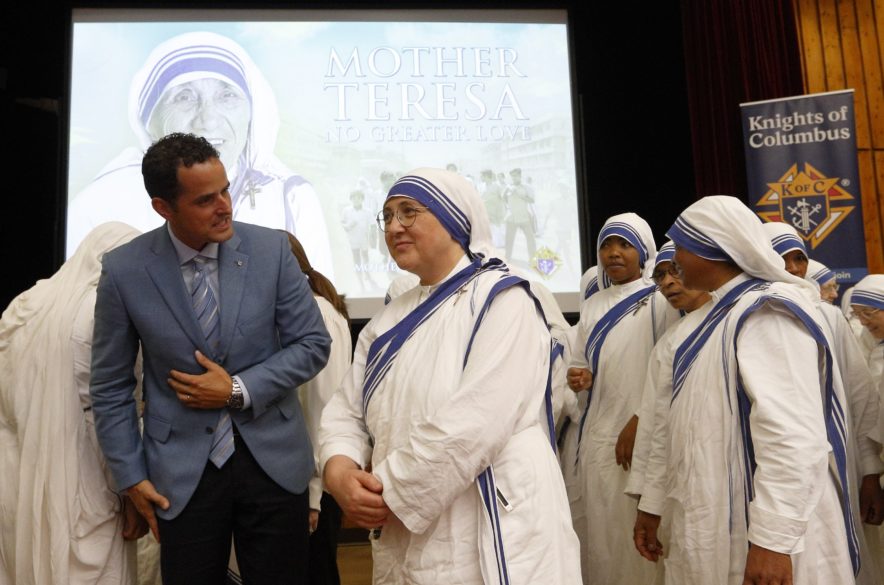
Mother Teresa was “an icon of the good Samaritan” who went “everywhere to serve Christ in the poorest of the poor. Not even conflict and war could stand in her way,” the late pope said.
Supreme Knight Patrick Kelly said at a news conference hosted at Vatican Radio Aug. 31 that the Knights made this film “to reach a new generation with the witness and example of Mother Teresa” and to inspire them.
Produced by the Knights of Columbus, “Mother Teresa: No Greater Love,” had its Vatican premiere Aug. 31, ahead of its release to more than 900 theaters Oct. 3 and 4.
“Thank you for all the efforts made to capture the life of this saint, whose life and testimony have borne much fruit,” wrote Pope Francis, who canonized her at the Vatican in 2016.
“Thank you for promoting this type of initiative that helps, in a creative manner, to make accessible the zeal for evangelization, especially for the young generations promoting the desire to follow the Lord who loved us first,” the pope said in an Aug. 25 letter written to Kelly, replying to news of the Vatican premiere.
Mother Teresa was born Agnes Ganxhe Bojaxhiu to Albanian parents in Skopje, now capital of North Macedonia, on Aug. 26, 1910. On Sept. 5, 1997, she died of cardiac arrest at the motherhouse of the Missionaries of Charity in Kolkata, India.
The documentary, by Emmy award-winning filmmaker, David Naglieri, features archival footage and interviews with dozens of commentators who knew Mother Teresa personally. It was filmed on five continents, providing interviews with many Missionaries of Charity and offering on-the-ground images of their work following in Mother Teresa’s footsteps.
The documentary shows the work Mother Teresa inspired and, “when she was feeding the hungry or holding the hands of someone as they lay dying, she was treating them as she would the most important person in her life, Jesus Christ himself,” Kelly said in a media release.
“She was teaching us to have a heart that sees, and if we can learn to see as she did, the world would be a radically different and, I would say, better place,” he said.
By Simon Caldwell
MANCHESTER, England (CNS) – Catholics in the U.K. paid tribute to Queen Elizabeth II following her death Sept. 8 and the end of a reign that lasted more than 70 years.
Pope Francis sent a telegram addressed “To His Majesty the King, Charles III,” her son who immediately ascended to the throne.
“I willingly join all who mourn her loss in praying for the late queen’s eternal rest and in paying tribute to her life of unstinting service to the good of the nation and the Commonwealth, her example of devotion to duty, her steadfast witness of faith in Jesus Christ and her firm hope in his promises,” Pope Francis said.
The British sovereign died “peacefully” at Balmoral, the royal residence in Scotland, surrounded by members of her family. She was 96.
Cardinal Vincent Nichols of Westminster, president of the Bishops’ Conference of England and Wales, paid tribute using many of the queen’s own words.
“On 21 April 1947, on her 21st birthday, Princess Elizabeth said, ‘I declare before you all that my whole life, whether it be long or short, shall be devoted to your service,’” Cardinal Nichols said. “Now, 75 years later, we are heartbroken in our loss at her death and so full of admiration for the unfailing way in which she fulfilled that declaration.”
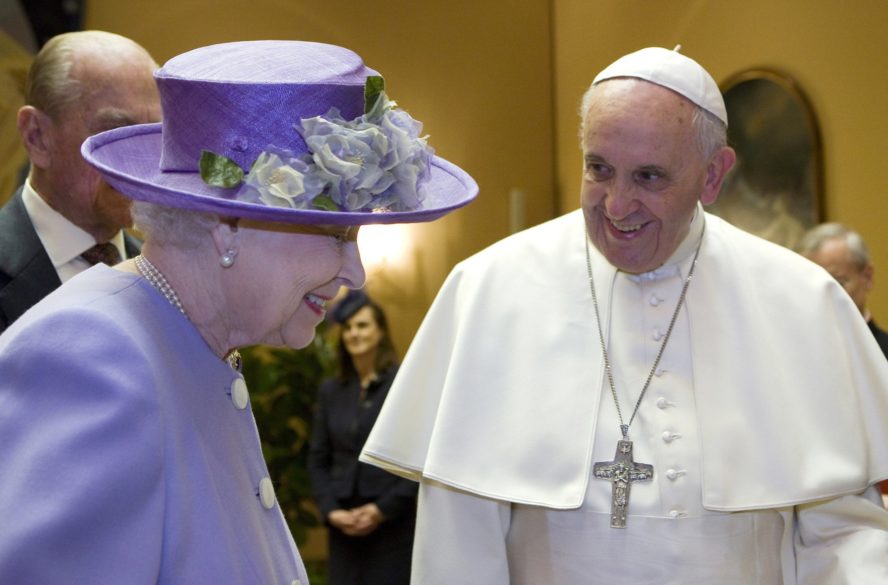
“Even in my sorrow, shared with so many around the world, I am filled with an immense sense of gratitude for the gift to the world that has been the life of Queen Elizabeth II,” he said. “At this time, we pray for the repose of the soul of Her Majesty. We do so with confidence, because the Christian faith marked every day of her life and activity.”
The cardinal quoted Queen Elizabeth’s Christmas message from 2000, in which she said the teachings of Christ and her own “personal accountability before God” gave her a framework of how to live, and that Christ’s words and example offered her “great comfort in difficult times.”
Cardinal Nichols said: “This faith, so often and so eloquently proclaimed in her public messages, has been an inspiration to me, and I am sure to many. The wisdom, stability and service which she consistently embodied, often in circumstances of extreme difficulty, are a shining legacy and testament to her faith.”
He also offered prayers “for His Majesty the King, as he assumes his new office, even as he mourns his mother. God save the king.”
Bishop Hugh Gilbert, president of the Bishops’ Conference of Scotland, praised Queen Elizabeth for her life of “outstanding and dedicated public service.”
“Her determination to remain active to the end of her long life has been an example of Christian leadership, which demonstrated her great stoicism and commitment to duty and was undoubtedly a source of stability and continuity in times of great change,” he said. “Scotland’s Catholic bishops will remember her in our prayers and pray for all those who mourn her loss.”
Anglican Archbishop Justin Welby of Canterbury said: “As we grieve together, we know that, in losing our beloved queen, we have lost the person whose steadfast loyalty, service and humility has helped us make sense of who we are through decades of extraordinary change in our world, nation and society.”
Queen Elizabeth died 17 months after the death of her husband, Philip, who died in April 2021 at age 99. Her 73-year marriage to Philip was the longest of any British sovereign.
The U.K. has entered a 10-day period of mourning.
Elizabeth was born on April 26, 1926, to Prince Albert, Duke of York, and Lady Elizabeth Bowes-Lyon.
She acceded to the throne Feb. 6, 1952, and during her coronation in Westminster Abbey June 2, 1953, Queen Elizabeth was open about her Christian faith.
“When I spoke to you last, at Christmas, I asked you all, whatever your religion, to pray for me on the day of my coronation to pray that God would give me wisdom and strength to carry out the promises that I should then be making,” the queen said in her address. “Throughout this memorable day, I have been uplifted and sustained by the knowledge that your thoughts and prayers were with me.”
The accession of 1952 made 2022 the year when the world’s oldest monarch and the longest-serving monarch in British history celebrated the platinum jubilee of her reign – the point when Elizabeth had sat on the British throne for 70 years.
The queen was able to witness the celebrations in her honor but handed over all of her public duties to her nearest relatives. Her final act of office was to receive Prime Minister Liz Truss in Scotland Sept. 6, when she was also last photographed.
Fourteen prime ministers served during her reign, beginning with Sir Winston Churchill. Truss was the 15th to greet her in that office.
During her reign, Queen Elizabeth met with four popes — Francis, Benedict, John Paul II and John XXIII, and as princess she met Pope Pius XII.
The queen sometimes joked about her longevity, once quoting Groucho Marx, saying: “Anyone can get old. All you have to do is live long enough.”